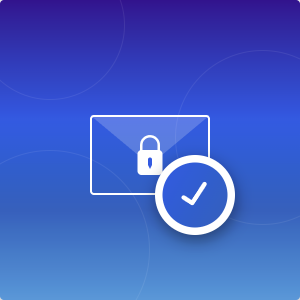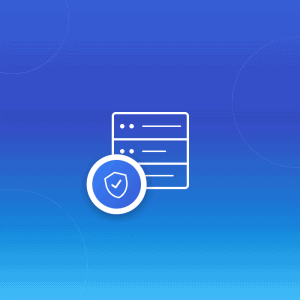Enterprise email security protects your business communications from phishing, malware, business email compromise (BEC), and data breaches. Over 90% of successful cyberattacks begin with an email. You need multifactor authentication, end-to-end encryption, employee training, and AI-powered threat detection to defend your organisation.
Key protections include implementing DMARC, SPF, and DKIM protocols, deploying behavioural AI to catch sophisticated attacks, and training employees to recognise social engineering attempts. These measures work together to create defence in depth.
Mailfence for Business offers end-to-end encryption with integrated calendar, documents, and collaboration tools – keeping your enterprise communications secure without sacrificing productivity.
Mailfence — Your secure Productivity Suite
Reclaim your Privacy with
- Messages
- Calendars
- Documents
- Groups
Introduction
Email remains the backbone of business communication, yet it’s become the primary target for sophisticated cyberattacks. Security teams now face a harsh reality: AI-powered phishing has exploded by 1,200%, creating threats that even experienced employees struggle to identify.
The threats have evolved dramatically. Attackers are using Large Language Models like GPT-4 to generate contextually relevant and personalised phishing emails that mimic a CEO’s tone or a vendor’s style. These aren’t the obvious scams from years past. They’re sophisticated, targeted, and devastating when successful.
According to the FBI, in 2023 business email compromise scams cost US companies $2.9 billion. A single breach now costs enterprises an average of $4.88 million. For small businesses, that number can mean closure. According to Verizon’s 2024 Data Breach Investigations Report, 82% of breaches involve the human element, while Gartner predicts that by 2025, 40% of organizations will use AI-augmented email security solutions.
Protection requires a strategic approach combining technology, training, and culture change. This guide focuses on battle-tested security measures that enterprises have successfully deployed against modern threats, with emphasis on practical implementation rather than theoretical concepts.
What is enterprise email security?
Enterprise email security is a comprehensive framework that includes a combination of technologies, policies, and practices designed to protect business email systems from unauthorized access, data breaches, and evolving cyberattacks. It goes beyond traditional spam filtering by targeting sophisticated threats such as phishing, malware, business email compromise (BEC), and insider risks like accidental data leaks.
Think of enterprise email security as a multi-layered defence system that safeguards communications on several fronts:
- External threats: It mitigates phishing attacks, malware delivery, ransomware, and other cyber threats that seek to exploit vulnerabilities in email communication channels.
- Internal risks: It helps prevent accidental data loss or leaks due to misdirected emails, which account for approximately 27% of all data protection incidents reported under GDPR, leading to more than $1.2 billion in fines worldwide.
Modern enterprise email security solutions integrate core components such as:
- Encryption: Secures email content during transmission and storage so that sensitive information is only accessible to intended recipients.
- Authentication protocols: Such as SPF, DKIM, and DMARC, verify the identity of the sender and ensure message integrity, reducing impersonation and spoofing.
- Behavioural analysis: Uses AI and machine learning to monitor email traffic patterns, detect anomalies, and flag suspicious activities that deviate from normal behaviour.
- User training: Empowers employees to recognize and respond to social engineering, phishing attempts, and other human-targeted attacks, strengthening the human element of security.
These combined elements form an adaptive defence mechanism because attackers continually probe for weaknesses; only a synchronized and multi-layered approach can effectively counteract these persistent threats.
Why 2025 changes everything for email security
The threat landscape has fundamentally changed. Recent Harvard Business School research (2024) shows AI can fool over 50% of humans, whilst reducing attack costs by more than 95% and increasing profitability up to 50-fold. Attackers have industrialised their operations.
Consider what happened to Toyota Boshoku Corporation. An employee was tricked by email into transferring the equivalent of $37 million to a fraudulent account. The email looked legitimate. The request seemed urgent. The money vanished.
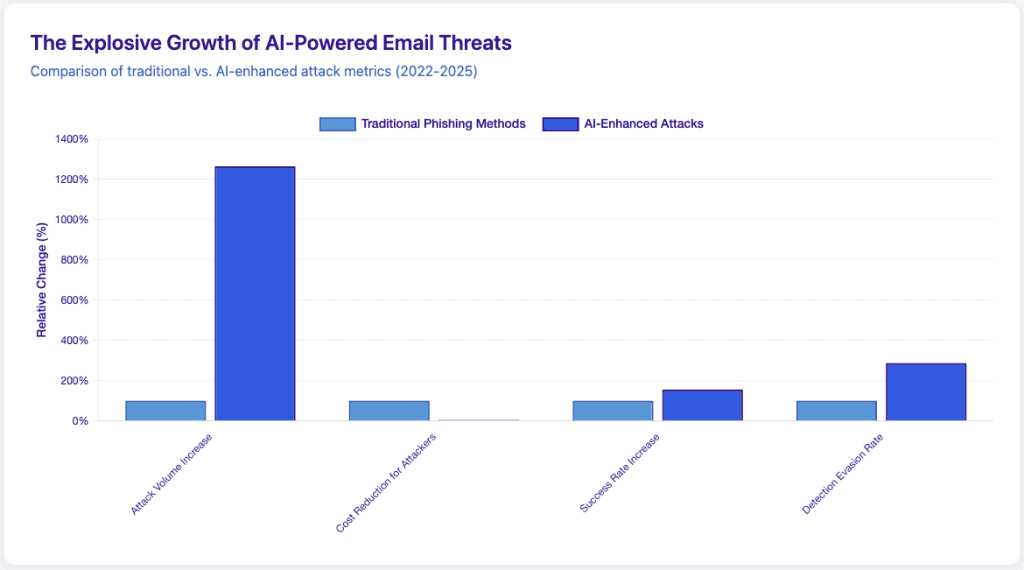
Your employees face these attacks daily. Employees face the overwhelming daily challenge of sifting through countless promotional messages or graymail to get to the emails that really matter. This constant barrage increases the likelihood of clicking something malicious.
Beyond financial losses, breaches destroy customer trust. Research shows 65% of customers lose confidence after a breach. Regulatory penalties compound the damage – GDPR fines can reach 4% of annual revenue.
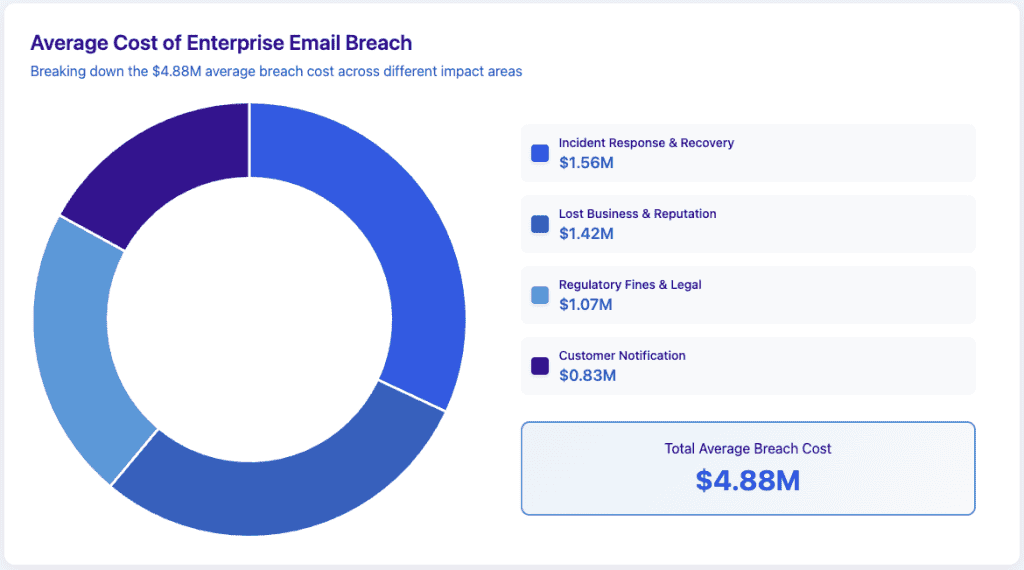
Understanding enterprise email security gateway architecture
Layer 1: modern enterprise email security gateway capabilities
Enterprise email security gateways act as your first line of defence. Traditional email filters use fixed rules and signatures: they block known-bad IPs and domains, scan for specific malicious keywords or attachments, and quarantine obvious spam.
But here’s the problem: signature and pattern limitations mean rule-based filters detect only what they know. New threats slip through because they haven’t been catalogued yet. Zero-day attacks exploit this weakness ruthlessly.
Modern enterprise email security gateway solutions now incorporate machine learning to identify suspicious patterns. They analyse sender reputation, message structure, and attachment behaviours. Yet even these advanced filters miss targeted attacks crafted for specific organisations.

Layer 2: message-level protection through encryption
Encryption protects your messages during transmission and storage. S/MIME encryption uses X.509 digital certificates issued by a trusted CA that tap into public-key infrastructure (PKI) to both encrypt and sign your email.
When you send an encrypted email, only the intended recipient can decrypt it. Even if intercepted, the content remains unreadable. This protection becomes critical when discussing contracts, financial information, or strategic plans.
The challenge has always been usability. Traditional encryption required technical expertise, certificate management, and recipient coordination. Many organisations abandoned encryption due to these hurdles.
Mailfence offers end-to-end encryption that works automatically. Your messages stay private from the moment you hit send until your recipient opens them. No technical expertise required. The system handles key management transparently.
Layer 3: behavioural analysis and AI detection
Today’s AI defences evaluate multiple threat indicators in real-time—from subtle changes in writing style to unusual network routing. Leading platforms report detection accuracy approaching 99.995%, though this varies significantly based on implementation and training data quality.
For example, if your CFO suddenly starts emailing from a new location at 3am requesting wire transfers, behavioural analysis catches this deviation. Traditional filters would miss it entirely.
AI systems learn normal communication patterns for each user, then flag anomalies that might indicate compromise. They analyse writing patterns, sending behaviours, network paths—all evaluated instantly against baseline behaviours.
These defences adapt constantly. As attackers develop new techniques, AI security evolves to counter them. The protection improves automatically without manual updates. According to Forrester’s Zero Trust Email Security Study (2024), organizations with mature email security see 73% fewer incidents.
Enterprise email security best practices for 2025
To help you build a strong defence, here is an overview of essential best practices that protect your organization’s communication channels.
For a quick dive into these topics, have a look at this practical and up-to-date video by Labyrinth Technology:
For anyone wanting to dive deeper, we recommend our Email Security and Privacy Course.
Multifactor authentication as the foundation
Multifactor authentication offers a crucial layer of defence, going above and beyond simple passwords to build additional factors into identity verification. Even if attackers steal passwords, they can’t access accounts without the second factor.
Choose authenticator apps or hardware keys over SMS verification. Text messages can be intercepted or redirected through SIM swapping attacks. Hardware tokens offer the strongest protection, especially for privileged accounts.
Password policies that actually work
Strong, unique passwords are essential, but certainly not sufficient on their own for preventing brute-force attacks. According to Hive Systems’ 2024 Password Table research, an 8-character password takes 5 minutes to crack, whilst a 16-character password takes 34,000 years.
Implement password managers organisation-wide. Tools like Bitwarden for Business, 1Password for Teams, or LastPass Enterprise offer centralised management with secure sharing for team credentials. These enterprise email security solutions handle credential management smoothly.
Email Gateway and Server Security Integration
A robust enterprise email security strategy includes deploying a secure email gateway (SEG) that acts as a fortified checkpoint for all incoming and outgoing email traffic. This gateway should implement advanced content filtering, URL scanning, attachment sandboxing, and quarantine policies to block phishing, malware, and other sophisticated threats before they reach users. Equally important is integrating endpoint protection that extends email security to user devices by running antivirus scans and endpoint detection systems to identify malicious files or network activity associated with email threats.
Meanwhile, email servers must be hardened by following best practices such as disabling unnecessary services, applying timely patches, enforcing strict access controls, and enabling Transport Layer Security (TLS) for encrypted communication. Maintaining this layered defence across gateway, endpoint, and server levels ensures comprehensive protection against modern email attack vectors and minimizes the risk of both external cyberattacks and internal data leaks.
Email authentication protocols
SPF, DKIM, and DMARC form the foundation of modern enterprise email security best practices. Understanding each protocol helps you implement them effectively.
SPF (Sender Policy Framework) confirms which servers can send mail for your domain. It’s a DNS record listing authorised IP addresses. Receivers check if incoming mail originates from approved servers.
DKIM (DomainKeys Identified Mail) adds cryptographic signatures to messages. Your server signs outgoing emails with a private key. Recipients verify using your public key in DNS.
DMARC (Domain-based Message Authentication, Reporting and Conformance) tells receiving servers how to handle failures. It builds on SPF and DKIM, adding policy enforcement and reporting.
Implementing enterprise email security best practices progressively
The verification of DMARC records, SPF, and DKIM isn’t just a technical exercise – it’s a critical defence mechanism against some of the most sophisticated cyber threats. These enterprise email security best practices form the foundation of sender verification.
Start with monitoring mode to understand your email flows. Review DMARC reports to identify legitimate senders. Gradually increase enforcement as you confirm proper configuration.
Data loss prevention strategies
98% of security leaders consider misdirected email as a significant risk when compared to other risks like malware and insider threats. Human error causes massive data leaks.
Implement outbound scanning rules as part of your enterprise email security gateway strategy. Flag messages containing sensitive patterns like credit card numbers, social security numbers, or confidential project names. Require confirmation before sending to external domains.
Deploy content-aware protection through your enterprise email security gateway. Automatically encrypt messages containing financial data. Block attachments with customer lists from leaving your domain. Tag emails by sensitivity level.
Building security awareness within your teams
Your team faces increasingly sophisticated attacks. Bad actors have begun using Gen AI to craft phishing emails, enhancing the language and customisation, making them increasingly difficult to spot. The European Union Agency for Cybersecurity (ENISA) reports that email remains the top initial access vector for 39% of incidents, while CrowdStrike’s 2024 Global Threat Report reveals the average breakout time is now just 62 minutes.
“Email remains the primary attack vector because it directly targets human psychology. The sophistication of modern attacks means technical defences alone aren’t enough – you need a culture of security awareness combined with robust encryption and authentication.” – Patrick De Schutter, Co-founder of Mailfence
Replace boring annual sessions with ongoing micro-training. Send weekly tips highlighting real attacks. Share screenshots of actual phishing attempts targeting your industry.
Create a culture where reporting suspicious emails is encouraged, not punished. Every reported attempt helps security teams protect the entire organisation.
Celebrate security wins publicly. When an employee spots a sophisticated phishing attempt, recognise them. Make security behaviours visible and valued.
Incident response preparation
Document your response procedures now. Who gets notified? What systems get isolated? How do you communicate with customers? Planning during crisis leads to poor decisions.
Run tabletop exercises quarterly. Simulate different attack scenarios. Test communication channels. Identify gaps in your procedures before attackers find them.
Speed matters enormously. IBM research notes that the single biggest factor differentiating costly breaches from contained ones is employee training and incident response speed.
Automate initial responses where possible. Suspicious account activity should trigger immediate password resets. Unusual data exports should alert security teams instantly.
AI’s impact on enterprise email security software
The attacker’s AI advantage
Leading threat analysts report explosive growth in phishing volume driven by AI: one report noted a 1,265% surge in phishing attacks linked to generative AI trends. Attackers automate personalisation at massive scale.
These aren’t generic spam campaigns anymore. AI crafts messages specifically for each target, referencing recent activities and mimicking writing styles. The psychological manipulation is precise.
Deepfake audio and video inside links or attachments impersonate executives requesting urgent wire transfers. Voice cloning makes verification calls unreliable.
Attackers study targets extensively. They learn speech patterns, common phrases, and decision-making processes. The resulting impersonations fool even close colleagues.
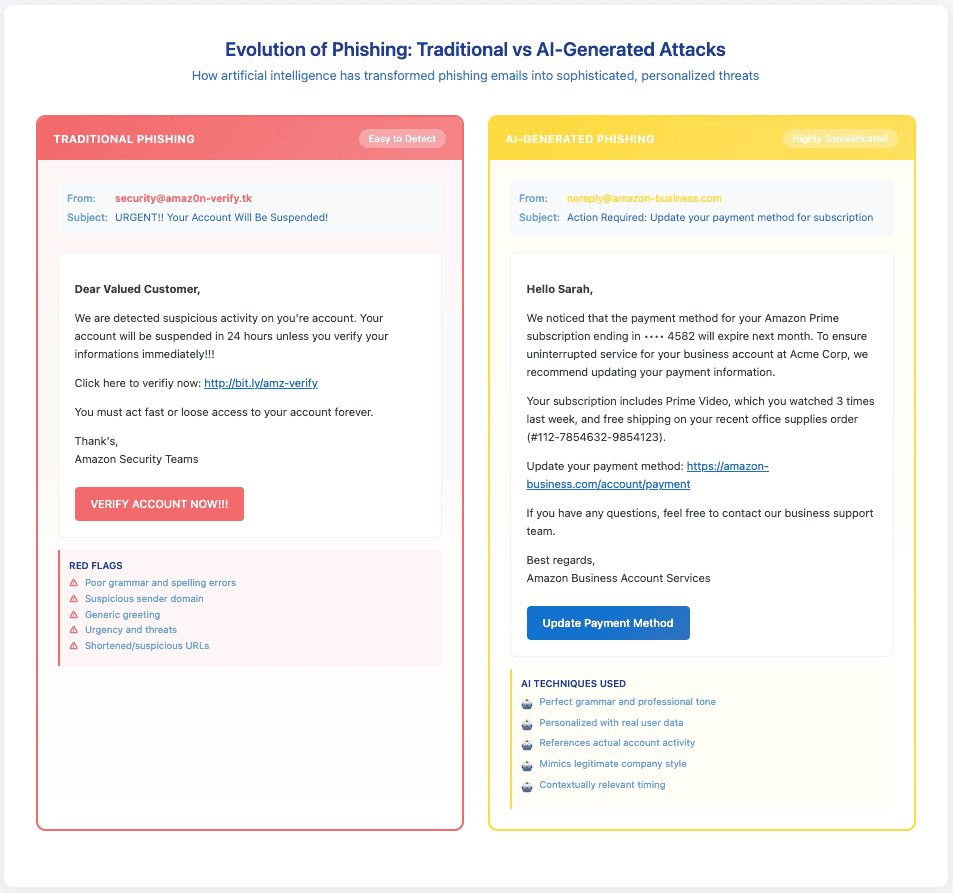
AI-powered defensive strategies in enterprise email security solutions
Third-generation email security platforms use LLMs as the central coordinator of analysis, not as a bolt-on module. Every email gets full evaluation from multiple perspectives.
These enterprise email security solutions break the prosecutor-only paradigm entirely. Every email gets its day in court, with AI acting as both defender and prosecutor whilst evaluating evidence objectively.
AI defences improve constantly. Each new attack pattern strengthens future detection. Organisations benefit from collective intelligence across the entire customer base.
How do I choose and implement an enterprise email security solution?
Start with your non-negotiables. End-to-end encryption? GDPR compliance? Integration with existing systems? Document requirements before vendor conversations begin.
Test with real scenarios. How quickly can the enterprise email security software detect targeted attacks? What’s the false positive rate? How much administrative overhead does it create?
Consider all costs, not just licensing. Factor in training time, integration expenses, and ongoing management. Hidden costs often exceed initial investments.
Calculate the cost of not acting. The average enterprise spends over 400 hours per year managing false positive alerts from inadequate tools. Better enterprise email security solutions pay for themselves through efficiency gains.
Change management for enterprise email security software deployment
People resist security measures that slow them down. Frame changes as productivity enhancements. Show how MFA prevents account lockouts from suspicious activity.
Offer clear documentation with screenshots. Create short video tutorials. Offer multiple support channels during transition.
Define success metrics upfront. Reduction in successful phishing attacks? Decreased time spent on security incidents? Improved compliance scores?
Share progress regularly. When phishing simulation click rates drop from 23% to 5%, celebrate. Make security improvements visible to leadership.
Implementing enterprise email security software in phases
Phase 1: foundation (weeks 1–4)
Start by understanding your vulnerabilities. Review recent security incidents. Identify which attacks succeeded and why. Document your current enterprise email security solutions and their effectiveness.
Audit user behaviours too. How many employees use weak passwords? Who has excessive permissions? Which departments handle the most sensitive data?
Phase 2: quick wins (weeks 5–8)
Deploy MFA on administrative accounts. These represent your highest risk. Then expand to finance, HR, and executive teams.
Implement basic DMARC monitoring through your enterprise email security gateway. You’ll discover shadow IT services sending email as your domain. Address these before enforcing strict policies.
Phase 3: full protection (weeks 9–16)
Roll out encryption for sensitive communications. Start with legal and finance teams who handle confidential data daily. Expand based on data classification.
Launch security awareness training alongside your enterprise email security software deployment. Focus on recognising AI-generated phishing. Use real examples from your industry.
Phase 4: optimisation (ongoing)
Monitor your enterprise email security services metrics constantly. Track attempted attacks blocked, successful phishing reports from users, and mean time to detect incidents.
Regular penetration testing reveals weaknesses. Red team exercises test your entire security programme. Use findings to strengthen defences iteratively.
Best email security vendors for enterprise 2025
Leading enterprise email security services
Microsoft 365 and Google Workspace dominate through integration and familiarity. Microsoft Defender for Office 365 now offers AI-powered email and collaboration security using purpose-built Large Language Models.
But they lack end-to-end encryption by default. Privacy-conscious organisations need additional layers. Default configurations often fall short of regulatory requirements.
Privacy-focused enterprise email security services
In our comparison of the 10 Best Secure Email Providers, few would fit in an enterprise setting. Mailfence stands as a strong contender in the privacy-focused segment of enterprise email security, especially attractive for businesses seeking European jurisdiction, end-to-end encryption, and all-in-one collaboration without sacrificing data sovereignty.
Mailfence — Your secure Productivity Suite
Reclaim your Privacy with
- Messages
- Calendars
- Documents
- Groups
Next-generation enterprise email security solutions
Companies like Abnormal and Sublime deploy specialised AI agents that autonomously stop targeted attacks. They excel at catching zero-day threats and novel attack patterns.
These enterprise email security services require significant investment. Initial false positive rates can disrupt operations. But for high-risk organisations, the protection justifies the cost.
Popular managed security service providers (MSSPs)
With the global shortage in cybersecurity professionals, many organisations can’t build internal security teams. Managed Detection and Response (MDR) offer expertise on demand.
MDR providers monitor your email 24/7. They investigate alerts, respond to incidents, and constantly tune defences. You get enterprise-grade security without recruitment challenges.
Proofpoint: Renowned for advanced threat intelligence, behavioural analysis, and forensic tools supporting deep threat protection and compliance needs.
Mimecast: Provides comprehensive email continuity solutions, targeted threat protection, and data loss prevention optimized for highly regulated industries.
Cisco Secure Email: Combines network-level intelligence with AI-driven filtering, strong encryption, and seamless integration with Cisco’s broader security ecosystem.
Barracuda Email Protection: Focused on ease of deployment with AI-powered anti-phishing and DMARC protection, ideal for smaller IT teams.
Check Point Harmony Email & Collaboration: Offers AI-powered defence across collaboration tools for organisations with internal IT expertise.
Trellix Email Security: Delivers attachment sandboxing, real-time analytics, and behaviour-based threat detection for large businesses with advanced SOCs.
Fortinet FortiMail: Provides configurable and all-in-one email security with built-in ransomware detection, ideal for organizations invested in Fortinet ecosystem.
Sophos Email: AI-driven threat protection with tight endpoint integration for businesses using Sophos products.
Trend Micro Email Security: Specializes in zero-day and ransomware defence with continuous threat updates.
Forcepoint Email Security: Industry-leading DLP capabilities focusing on data protection with thousands of predefined classifiers and AI analytics.
Key takeaways: enterprise email security
- Business email compromise scams cost US companies $2.9 billion in 2023, making email your biggest security risk
- AI has changed phishing – attacks are up over 1,200% and bypass traditional filters
- Multifactor authentication, encryption, and behavioural AI form your core defences
- Employee training remains critical – even the best technology can’t prevent all human error
- Ongoing monitoring and adaptation are essential as threats evolve daily
Final thoughts on enterprise email security
Email security in 2025 demands a fundamental shift in thinking. The old perimeter-based defences have crumbled. AI-generated phishing is the defining email security challenge, and traditional solutions can’t keep pace.
Protection requires multiple layers working in concert. By combining strong authentication, encryption, AI-powered detection, and ongoing training, you create resilient defences. Each layer compensates for others’ weaknesses.
Mailfence offers a powerful alternative for privacy-conscious enterprises. Our secure email platform includes end-to-end encryption, digital signatures, and two-factor authentication – all integrated into a full productivity suite.
Want to stay updated on the latest email security threats and defences? Follow our newsletter for weekly insights and practical tips.
Get the latest privacy news in your inbox
Sign up to the Mailfence Newsletter.
Frequently Asked Questions
What are the 3 types of email security?
The three main types are gateway security, message encryption, and behavioural analysis. Gateway security filters incoming threats using rules and signatures. Message encryption protects content during transmission using protocols like S/MIME or PGP. Behavioural analysis uses AI to detect anomalies in user patterns. Mailfence combines all three approaches, offering encrypted communications with intelligent threat detection in a single platform.
What is enterprise email security?
Enterprise email security protects business email systems from cyber threats, data breaches, and unauthorised access. It includes technologies like spam filtering, malware detection, encryption, and authentication protocols. According to research, over 90% of successful cyberattacks begin with an email, making robust email security essential for business continuity. Modern solutions like Mailfence add end-to-end encryption and secure collaboration tools.
What are the best practices for enterprise email security?
Start with multifactor authentication on all accounts. Deploy end-to-end encryption for sensitive data. Train employees regularly on threat recognition – AI-generated phishing has made attacks increasingly difficult to spot. Configure SPF, DKIM, and DMARC properly. Monitor user behaviour for anomalies. Keep all systems updated and patched.
Who has the best email security?
The "best" depends on your specific needs. Next-generation platforms deploy specialised AI agents that autonomously stop targeted attacks. For privacy-focused organisations, Mailfence offers exceptional security with end-to-end encryption, digital signatures, and GDPR compliance. Unlike mainstream providers, we never scan your emails for advertising or data mining.
How does AI affect enterprise email security?
AI has changed both attacks and defences. Recent Harvard Business School research (2024) shows AI can fool over 50% of humans whilst reducing attack costs by more than 95%. Simultaneously, AI-powered defences achieve remarkable accuracy – some systems report 99.995% attacker intent detection. Organisations must deploy AI defences to counter AI-generated threats effectively.


